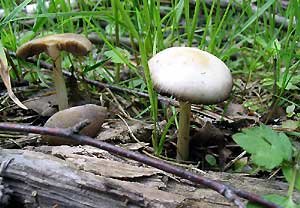Psathyrella candolleana (Psathyrella candolleana)
- Division: Basidiomycota (Basidiomycetes)
- Subdivision: Agaricomycotina (Agaricomycetes)
- Class: Agaricomycetes (Agaricomycetes)
- Subclass: Agaricomycetidae (Agaricomycetes)
- Order: Agaricales (Agaric or Lamellar)
- Family: Psathyrellaceae (Psatyrellaceae)
- Genus: Psathyrella (Psatyrella)
- Type: Psathyrella candolleana (Psathyrella Candolle)
- False honeysuckle Candoll
- Khruplyanka Kandollya
- Gyfoloma Candoll
- Gyfoloma Candoll
- Hypholoma candolleanum
- Psathyra candolleanus

Hat: in a young fungus, bell-shaped, then relatively prostrate with a slight smooth elevation in the center. The diameter of the cap is from 3 to 7 cm. The color of the cap varies from almost white to yellow with brown. Along the edges of the cap, you can see specific white flakes – the remaining parts of the bedspread.
Pulp: whitish-brown, brittle, thin. It has a pleasant mushroom aroma.
Records: in a young mushroom, the plates are grayish, then they become darker, taking on a dark brown color, dense, adherent to the stem.
Spore Powder: purplish-brown, almost black.
Leg: hollow, cylindrical in shape with a slight pubescence in the lower part. Off-white cream color. Length from 7 to 10 cm. Thickness 0,4-0,8 cm.
Spread: fruiting time – from May to early autumn. Psatirella Candolla is found in deciduous and mixed forests, in vegetable gardens and parks, mainly on the roots and stumps of deciduous trees. Grows in large groups.
Similarity: A distinctive feature of Psathyrella candolleana is the remains of a veil on the edges of the cap. If the remains have not been preserved or have gone unnoticed, then you can distinguish Kandol mushroom from various types of champignons by their place of growth – in groups on dead wood. Also on the leg of this fungus there is no clearly defined ring. From the representatives of the genus Agrotsibe, Candol’s honey agaric is distinguished by a darker color of the spore powder. The fungus differs from the closely related Psathyrella spadiceogrisea in its lighter color and larger fruiting bodies. In addition, it is worth noting that the fungus is quite variable. Candola mushroom can acquire the most unexpected masks, depending on humidity, temperature, place of growth and age of the fruiting body. At the same time, the candola mushroom is completely different from the popular edible mushrooms, no matter what shades the sun gives it.
Edibility: Old sources classify the Psatirella Candolla mushroom as an inedible and even poisonous mushroom, but modern literature calls it a mushroom that is quite suitable for consumption, requiring preliminary boiling.









